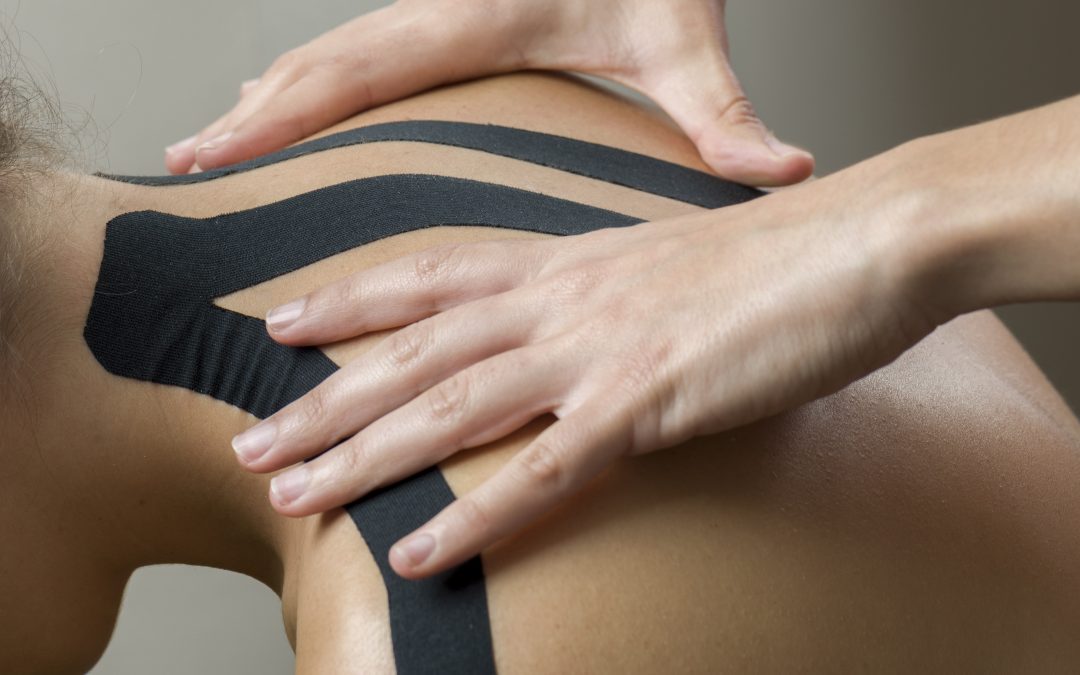Every athlete, Olympic or otherwise, has a training and recovery regimen in which they participate. In the last several years, you may have noticed these athletes wearing either black or colorful tape on their skin in varying patterns. This wrapping is kinesiology tape, and it’s an injured athlete’s best friend.
Coming into the public eye during the 2008 Summer Olympics, kinesiology tape quickly became a go-to modality for therapists working with athletes. And for good reason.
What is Kinesiology Tape?
Kinesiology tape, also called KT tape, is an elastic, adhesive tape meant for skin application. It’s hypoallergenic and designed for multi-day wear. And since it’s water-resistant and stretches with them, athletes can wear it during practice and games or events. It also reduces pain and swelling and assists in muscle recovery.
KT tape allows athletes to continue performing while injured as it provides support as well. Because it both aids in pain and inflammation relief, players can train/compete while the injury is still healing. This is a massive benefit for professional and competitive athletes.
What Does It Do?
Relieves pain
Kinesiology tape helps to alleviate muscle discomfort. When applied to the skin, it microscopically lifts the outer layer away from the muscle, forming minor helices which creates more space between skin cells. The increase of spaces allows for a decrease in inflammation and provides better blood and lymphatic fluid flow to and from the area.
It also affects the nerve endings located in between these two layers. When the pressure on them is released, they send signals to the brain to tell it that they’re no longer threatened. The brain can then send signals to the rest of the body that it is no longer under threat, and it can adjust accordingly.
Reduces swelling
The stimulation of the skin and blood flow also blocks signals to the brain’s pain receptors. This is particularly useful to athletes with sensitive injuries. The increased flow of the lymphatic fluids allows drainage of anything collecting in the injured area which reduces swelling.
Assists in contusion recovery
This also works for healing bruises. A therapist will fan out the KT tape over the area to raise the skin, and after a few days when the tape is removed, the fanned pattern can be seen on the skin.
Assists in cramping and spasms
Because kinesiology tape improves circulation to the applied area, oxygen reaches it more easily, keeping muscle cramps at bay.
Aids in overall recovery
Lactic acid tends to build up in overused, overwrought muscles – the improved circulation brought by the KT tape assists in speeding up recovery time. And healing faster means getting back in the game faster.
How Does It Pair with Massage Therapy?
Massage therapy and kinesiology do not have to be kept separate. In fact, the use of KT tape is often considered a modality of massage therapy. Aside from reducing inflammation, kinesiology tape also promotes circulation and muscle healing – qualities parallel with massage therapy. It supports tendons, ligaments, and joints, all areas which therapists work on to promote healing in an athlete.
Once the therapist is finished treating the soft tissue for the session, taping helps to prolong the effects of the therapy until it’s removed (3-5 days). Think of it as having the massage therapist still with you for several days after the session.
Kinesiology Tape and Athletic Injuries
KT tape can be useful in many situations, but some common injuries have seen the most benefit with the treatment:
Back pain
It isn’t exclusive to athletes, so anyone suffering from back pain can benefit from using kinesiology tape. These muscles are often overworked and distressed, so taping often involves building a support-frame to support them.
Knee injuries
The KT tape anchors the injury (usually the hamstring, quadriceps, or patella) to balance out the weakness and support the knee.
Rotator cuff injuries
Because the shoulder joint is so unstable, injuries here are not uncommon. The tape helps stabilize the injured muscles to reduce any strain on them until they’ve had time to heal.
Shin splints
When dealing with shin splints, a therapist will tape the leg in a radial pattern – this supports the muscles along the tibia, reducing healing time.
Tennis elbow
When KT tape is applied to the elbow, it relieves pressure on the tendon and evenly distributes it across the rest of the arm.
All this being said, kinesiology tape isn’t just for athletes. Anyone suffering from similar injuries can benefit from its use. But not everyone can apply it. Only trained professionals can place KT tape so it has the desired effect.
At MG Sports Massage, we are trained in kinesiology taping and use RockTape® in our practice. For questions or to book a session, contact us.

